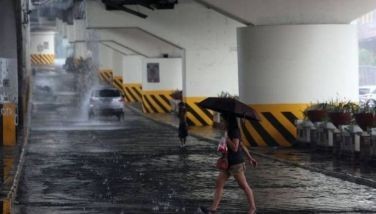Dengue cases on the rise in 7 regions
MANILA, Philippines - An increase in dengue cases was reported in seven regions from Jan. 1 to Sept. 5, a report of the Department of Health (DOH) showed.
The DOH said 78,808 dengue cases were reported, 16.5 percent higher than the 67,637 cases recorded during the same period in 2014. The death toll, however, is lower at 233 compared to 297 last year.
Cagayan Valley posted the highest increase at 215.4 percent or from 1,781 cases in 2014 to 5,618 cases this year, followed by the Cordillera Autonomous Region with 2,508 cases, representing an increase of 152 percent compared to 1,448 cases last year.
Metro Manila posted an
increase of 122.7 percent or from 3,636 to 8,099 cases and Central Luzon, 114.5 percent or 11,806 cases from 5,505 in 2014.
The number of cases in Calabarzon rose from 6,074 to 11,894 or an increase of 95.8 percent, while the cases in the Ilocos Region went up from 3,676 to 6,501 cases, or an increase of 76.8 percent.
The Autonomous Region in Muslim Mindanao recorded an increase of 28.2 percent or from 933 to 1,196 cases.
The ages of patients ranged from less than one month to 99 years old.
Dengue strains
Samples collected from 20 sentinel sites nationwide showed 660 laboratory confirmed dengue cases in which all four dengue virus (DENV) serotypes 1, 2, 3 and 4 were present.
The predominant strains of dengue virus were DENV-1 (37.1 percent) and DENV-2 (31.8 percent).
None of the four strains is more virulent than the other but there is usually one or two particular strains that become predominant every year. Having all of the serotypes present at the same time could mean more people being infected with dengue.
An infection with one serotype gives a person immunity from the strain for life.
A person afflicted with dengue has a sudden onset of high fever, which may last from two to seven days, joint and muscle pain and pain behind the eyes, weakness, skin rashes, nose bleeding when fever starts to subside, abdominal pain, vomiting of coffee-colored matter, dark-colored stools and difficulty in breathing.
The DOH said a dengue patient should not be given aspirin for fever as it could only worsen the bleeding.
The DOH is promoting the 4S strategies – search and destroy possible mosquito breeding sites, self-protection measures, seek early consultations and say yes to fogging in case of an impending outbreak or a hotspot for dengue.
Hospital extension
The Philippine Red Cross (PRC) said it is willing to help set up extensions for hospitals overwhelmed by dengue patients.
“We are now checking if there is additional need for blood or maybe an increase in hospital bed capacity. If needed, we can set up extension of hospitals,” PRC secretary general Gwen Pang said.
The PRC set up field hospitals in key areas during the visit of Pope Francis in January. The hospitals were fully equipped and manned by trained personnel and volunteers.
The PRC has enough blood supply for victims of dengue and other medical needs, PRC chairman Richard Gordon said.
Gordon said the PRC has around 7,000 bags of blood in its blood banks, higher than the usual stock of some 5,000 bags.
The PRC now supplies 52 percent of the country’s blood needs. It has 27 blood centers and 82 blood banks nationwide, all connected to its central offices in Manila via computer and telecom facilities to give status reports on blood supply twice a day.
- Latest
- Trending





























